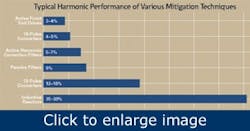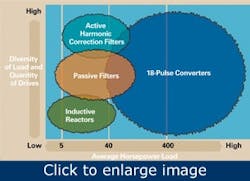Control harmonic distortion to reduce energy consumption and extend asset life
Increasingly, facilities are using drives to achieve energy savings, precision control and intelligent automation. Yet it’s critical to understand how harmonics can affect your assets. Working with a knowledgeable drive manufacturer supplying a range of solutions to meet unique application requirements, businesses are better able to find the most effective solution to mitigate harmonics in their environments. Solutions that mitigate harmonics also reduce electrical consumption and extend equipment life.
The basics: What are harmonics?
Figure 1. Producing harmonics is easy. A perfect wave with a frequency of 60 Hz (upper left) is close to what the utility supplies. Second wave (upper right) is the 5th harmonic of the fundamental frequency — 300 Hz — which is typical of the frequency a fluorescent lamp adds to the line. When the two waves combine (lower), the result is a symmetrical, harmonic-rich, 60-Hz supply with the same frequency as the fundamental but devoid of its original sinusoidal character.
Harmonics are distorted electrical waveforms (Figure 1) that introduce inefficiencies into an electrical system. Harmonics produce wasteful heat and can’t be converted into useful energy.
The effects of harmonics on a system are comparable to the consequences of putting bad fuel in a car – it burns inefficiently and can net more trips to the service station. The engine works harder, runs hotter and loses efficiency. It causes more pollution and failed emissions testing, resulting in fines. Although it might cost less initially, bad fuel is likely to cost more in the long run.
Nonlinear loads that convert AC line voltage to DC inject harmonics into an electrical system. A range of equipment can do this; nonlinear electronic switching devices include:
- Adjustable frequency drives (AFDs)
- UPS systems
- Computer power supplies
- Energy-efficient lighting
- Punch presses
- Welders
- DC power supplies
Linear loads, such as motors that run across the line, don’t add harmonics. Many fluid handling applications use a throttling valve to reduce the flow of material, but without reducing the load to the motor significantly. Although it yields some level of control, a throttling valve consumes considerably more energy than using an adjustable frequency drive. All in all, large linear loads draw more energy than variable frequency drives, because they can’t control motor speed.
Hard-to-see harmonic-induced problems are easily overlooked. It’s critical that plants with heavy motor, AFD and lighting loads understand the problems harmonics can trigger. Too much harmonic distortion can result in slow and steady damage to sensitive electronic equipment and motors that run across the line. In the long term, harmonics can cause:
- Increased electrical consumption
- Added wear and tear on motors and other equipment
- Greater maintenance costs
- Upstream and downstream power-quality problems
- Utility penalties for causing problems on the power grid
- Overheating in transformer
Adhering to applicable standards
IEEE 519-1992 is the standard that addresses harmonic distortion. Written from the point of view of electrical utilities, it’s a system recommendation and establishes the level at which electrical energy is determined to be “clean.” IEEE 519-1992 provides guidelines for commercial and industrial users using medium- and low-voltage equipment.
[pullquote]To comply with the IEEE standards, total harmonic distortion is calculated under worst-case conditions. Harmonic calculations are based on the kVA capacity and short-circuit-to-load ratio of the local medium- to low-voltage step-down transformer feeding the system. The calculations are made with the point of common coupling being the juncture where the utility feeds multiple customers.
IEEE 519 looks at both current and voltage distortion. The intent of the standard is to ensure that one plant isn’t producing harmonics that could affect another plant on the power grid. In other words, your harmonics shouldn’t interfere with your neighbor’s system.
Clean power, drives to meet specific requirements
There’s a spectrum of solutions to help minimize harmonic distortion. A harmonic analysis can provide guidance about the best way to mitigate any harmonic contributions to an electrical system.
Reactors or chokes: The first approach to reducing harmonics from a drive is to add impedance, either in the form of an AC line reactor or DC bus choke. Typically, this is a low-cost and technically simple solution, but it’s likely to reduce only higher-order harmonics and has little effect on the 5th and 7th harmonics. Additionally, there’s an associated voltage drop, which means there are limits to the amount of impedance that can be added.
Both AC and DC reactors deliver similar harmonic mitigation, but AC reactors provide additional protection to the drive rectifier bridge. Reactors are typically rated between 1.5% and 5% — the industry standard is 3%. Because of diminishing returns and voltage drop, higher percentage reactors seldom are used. Typically, 3% reactors yield about 35-38% current distortion, with 5% reactors dropping this to 33% to 35%.
Unchecked harmonics degrade the system performance and the bottom line:
- Increased installation and energy costs. Harmonics can harm transformers and reduce efficiencies through I2R power losses.
- Downtime and decreased productivity. The lifespan of electronic equipment and motors that run across the line is reduced when connected to power grids contaminated with harmonics.
- Emergency generators. Backup generators can have more than three times the impedance than is found in conventional utility sources. As a result, the harmonic content can be as much as three times as large, potentially preventing the generator from operating properly.
- Larger motors are required. Because they run across the line and are connected to contaminated power distribution grids, motors can overheat and operate at lower efficiency because of harmonics.
- Increased installation costs. Transformers and power equipment need to be oversized to accommodate the loss of efficiencies because of the harmonic currents circulating through the distribution.
12-pulse converters: These incorporate two separate AFD input semiconductor bridges, which are fed from 30° phase-shifted power sources with identical impedance. This arrangement allows the harmonics from the first converter to cancel the harmonics of the second, especially the 5th and 7th harmonics.
Twelve-pulse converters reduce voltage and current harmonics as much as 85% when compared to six-pulse AFDs. This results in about 12% current distortion. However, the 12-pulse converters have been largely superseded by 18-pulse converters on larger-horsepower systems because of the significant harmonic attenuation benefits provided by the newer technology.
On systems smaller than 100 hp, 12-pulse converters have been largely superseded by passive filter solutions because of cost.
Passive filters: Designed for small and mid-size applications, usually smaller than 100 hp, passive inductive and capacitive (L-C-L) filters block harmonics from being transferred to the electrical distribution system. They reduce line harmonics at the drive input terminals, resulting in approximately 7% current distortion. A high-impedance primary inductor blocks higher-order harmonics, while a shunt-connected tuned reactor connected to a capacitor mitigates the 5th and 7th harmonics. Passive filters are a low-cost popular solution. Further, modern passive filter designs do a better job in cleaning up harmonics from the drive only, as opposed to the traditional designs which absorbed system harmonics and became overloaded.
The drive manufacturer should provide and install harmonic filters in the same enclosure as the drive. Following this practice ensures the passive filter is sized correctly for the drive.
Figure 2. Degrees of current distortion remain after treatment with various technologies.
Active harmonic correction filters: These are high-performance inverters that measure system harmonics through current transformers and inject harmonics of equal amplitude and opposite phase into the system. This can be suitable for systems where low-horsepower loads are numerous and diverse, as a single active filter can mitigate the distortion effects of many drives. They also can be useful for retrofit applications, because they’re a shunt-connected device. These systems typically are costly and rarely applied to single-drive, high-horsepower applications.
Active front end drives: The active front end drive is newer technology designed for regenerative loads and has an added benefit of reducing harmonics. This device combines the characteristics of the active filter and passive filter as it requires an inductive-capacitive filter to separate the high frequency IGBT switching from the line. The expense of an active front-end drive can be prohibitive in a variety of applications and is more fitting only for regenerative and common DC bus applications.
Figure 3. The 18-pulse converter has a wider operating range than alternative technologies.
18-pulse converters: A simple, single-source solution, an 18-pulse converter is well-suited for critical loads to provide comprehensive protection for critical equipment. Drives with 18-pulse converters meet IEEE 519 standards by reducing current distortion to 5% or less. Reducing harmonics at the drive input terminals stops harmonics at the source. Further, the 18-pulse converter increases drive life by means of a stable DC bus voltage. Providing 50% better harmonic ratings than 12-pulse converters, the 18-pulse converter is, when looking at the combination of harmonic mitigation and cost, the most effective solution at 100 hp or more. In addition, by using passive components such as diodes, rectifiers and transformers, the 18-pulse drives provide the most rugged solution (Figure 2 and 3).
Eighteen-pulse converters have a near sine wave input current and low harmonics. An efficient, new technology, the 18-pulse drive has helped manufacturing plants around the world reduce harmonics. Key advantages include:
- Meets IEEE standards
- Addresses higher-order harmonics (to the 35th)
- Stops harmonics at the source
- Adaptable to future system changes
- Increases the life of the drive through a stable DC bus voltage
Controlling harmonic distortion can reduce energy consumption and extend the life of your assets in this competitive business environment.
Unmanaged harmonics are expensive. Both motors and distribution transformers can lose as much as 1% of efficiency when installed on systems with significant harmonic content. In effect, that 1% of inefficiency turns into heat and can result in a 10° C higher operating temperatures, which can reduce the life of a motor as much as half. Managing system harmonics makes good business sense and increases the life of your assets.
Timothy Skell is an application engineer at Eaton Corp. He can be reached at [email protected].



